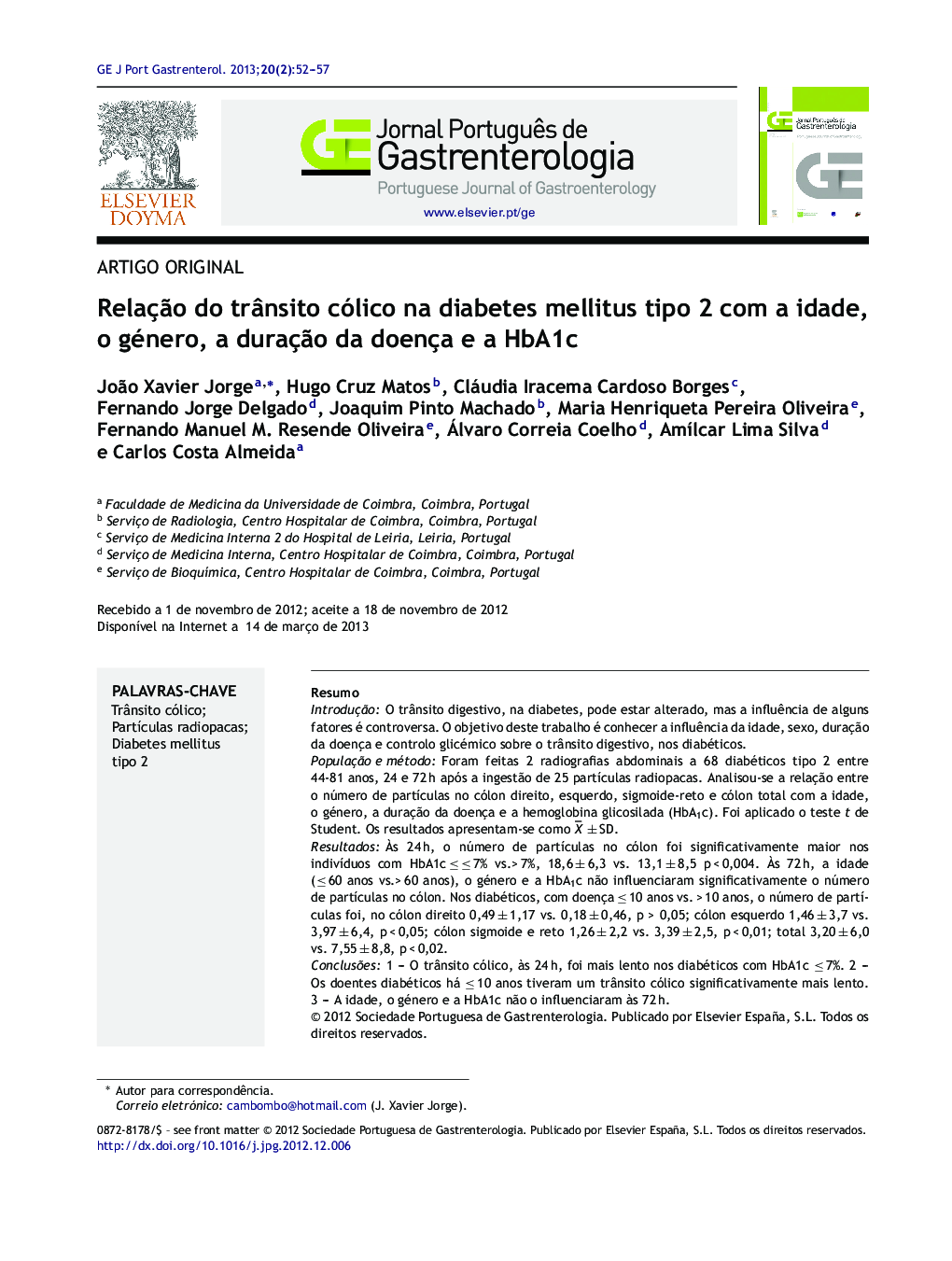| Article ID | Journal | Published Year | Pages | File Type |
|---|---|---|---|---|
| 3311115 | GE Jornal Português de Gastrenterologia | 2013 | 6 Pages |
ResumoIntroduçãoO trânsito digestivo, na diabetes, pode estar alterado, mas a influência de alguns fatores é controversa. O objetivo deste trabalho é conhecer a influência da idade, sexo, duração da doença e controlo glicémico sobre o trânsito digestivo, nos diabéticos.População e métodoForam feitas 2 radiografias abdominais a 68 diabéticos tipo 2 entre 44-81 anos, 24 e 72 h após a ingestão de 25 partículas radiopacas. Analisou-se a relação entre o número de partículas no cólon direito, esquerdo, sigmoide-reto e cólon total com a idade, o género, a duração da doença e a hemoglobina glicosilada (HbA1c). Foi aplicado o teste t de Student. Os resultados apresentam-se como X¯ ± SD.ResultadosÀs 24 h, o número de partículas no cólon foi significativamente maior nos indivíduos com HbA1c ≤ ≤ 7% vs.> 7%, 18,6 ± 6,3 vs. 13,1 ± 8,5 p < 0,004. Às 72 h, a idade (≤ 60 anos vs.> 60 anos), o género e a HbA1c não influenciaram significativamente o número de partículas no cólon. Nos diabéticos, com doença ≤ 10 anos vs. > 10 anos, o número de partículas foi, no cólon direito 0,49 ± 1,17 vs. 0,18 ± 0,46, p > 0,05; cólon esquerdo 1,46 ± 3,7 vs. 3,97 ± 6,4, p < 0,05; cólon sigmoide e reto 1,26 ± 2,2 vs. 3,39 ± 2,5, p < 0,01; total 3,20 ± 6,0 vs. 7,55 ± 8,8, p < 0,02.Conclusões1 – O trânsito cólico, às 24 h, foi mais lento nos diabéticos com HbA1c ≤ 7%. 2 – Os doentes diabéticos há ≤ 10 anos tiveram um trânsito cólico significativamente mais lento. 3 – A idade, o género e a HbA1c não o influenciaram às 72 h.
IntroductionIn diabetes, the digestive transit may be altered. Nevertheless, the influence of some factors is controversial. The aim of this study is to examine the influence of age, gender, disease duration and HbA1c on the colonic transit of diabetic patients.Population and methodsThirty eight type 2 diabetic patients, aged between 44 and 81, were enrolled. Two abdominal radiographs were conducted, 24 and 72 hours after the ingestion of 25 radiopaque particles. We examined the relationship between the number of particles in the right and left colon, sigmoid colon - rectum and total colon and age, gender, disease duration and glycosylated hemoglobin (HbA1c). t statistics were performed, and the results are in mean ± SD.ResultsAt 24 hours, the number of particles in the colon was significantly higher in patients with HbA1c ≤ 7%/l vs. > 7%, 18.6 ± 6.3 vs. 13.1 ± 8.5 p < 0.004, and, at 72 hours, the age (≤ 60 years vs. > 60 years), gender and HbA1c did not influence significantly the number of particles in the colon. In patients with disease duration ≤ 10 years vs> 10 years, the number of particles in the right and left colon were: 0.49 ± 1.17 vs. 0.18 ± 0.46, p > 0.05, 1.46 ± 3.7 vs. 3.97 ± 6.4, p < 0.05, respectively. In the sigmoid colon and rectum were: 1.26 ± 3.39 vs. 2.2 ± 2.5, p < 0.01, and total 3.20 ± 6.0 vs. 7.55 ± 8.8, p < 0.02.Conclusions1 - At 24 hours, patients with HbA1c ≤ 7% had significantly more particles in the colon. 2 - At 72 hours, the patients with ≤ 10 years of disease had significantly less radiopaque particles in the colon. 3 - The age, gender, and the HbA1c did not have any effects, at 72 h.
